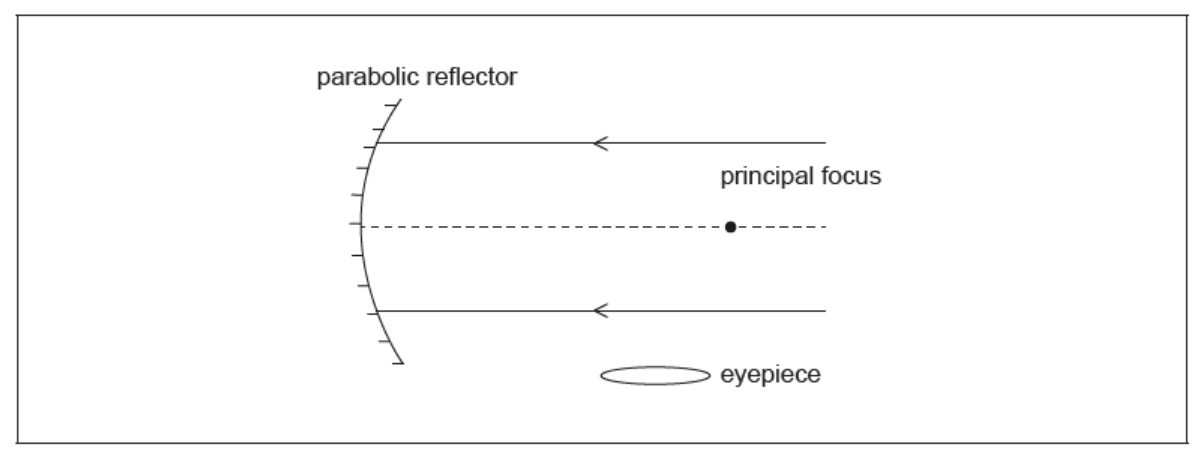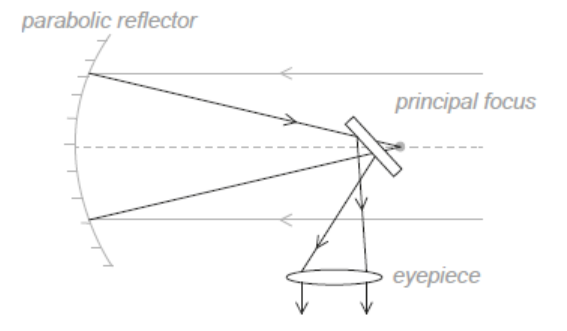Question
A small object is placed at a distance of $2.0 \mathrm{~cm}$ from the objective lens of an optical compound microscope in normal adjustment.
The following data are available.
$
\begin{array}{ll}
\text { Magnification of the microscope } & =70 \\
\text { Focal length of the eyepiece } & =3.0 \mathrm{~cm} \\
\text { Near point distance } & =24 \mathrm{~cm}
\end{array}
$
a. State what is meant by normal adjustment when applied to a compound microscope.[1]
b. Calculate, in $\mathrm{cm}$, the distance between the eyepiece and the image formed by the objective lens.[2]
c. Determine, in $\mathrm{cm}$, the focal length of the objective lens.[3]
▶️Answer/Explanation
Ans:
a. «the final» image is formed at the near point of the eye $\checkmark$
b. «image is virtual so» $v=-24$ «cm»
$
« \frac{1}{u}=\frac{1}{3.0}+\frac{1}{24} » \text { so } u=27 \text { «cm» }
$
c. $M_{\mathrm{e}}=\frac{v}{u}=\frac{24}{2.66}=9.0$ AND $M_{\mathrm{o}}=\frac{7.0}{9.0}=7.8$
$
v_0=2.0 \times 7.8=15.6\langle\mathrm{~cm} »
$
$
« \frac{1}{f}=\frac{1}{2}+\frac{1}{16} » \text { so } f_0=1.8 \text { «cm» }
$
NOTE: MP1 allow $M_e=\frac{D}{f}+1=9$
Question
An astronomical reflecting telescope is being used to observe the night sky.
The diagram shows an incomplete reflecting telescope.

a. Complete the diagram, with a Newtonian mounting, continuing the two rays to show how they pass through the eyepiece.[3]
b. When the Earth-Moon distance is $363300 \mathrm{~km}$, the Moon is observed using the telescope. The mean radius of the Moon is $1737 \mathrm{~km}$. Determine
the focal length of the mirror used in this telescope when the diameter of the Moon’s image formed by the main mirror is $1.20 \mathrm{~cm}$.[2]
c. The final image of the Moon is observed through the eyepiece. The focal length of the eyepiece is $5.0 \mathrm{~cm}$. Calculate the magnification of the
telescope.[1]
d. The Hubble Space reflecting telescope has a Cassegrain mounting. Outline the main optical difference between a Cassegrain mounting and a
Newtonian mounting.[1]
▶️Answer/Explanation
Ans:
a. plane mirror to the left of principal focus tilted anti-clockwise two rays which would go through the principal focus two rays cross between mirror and eyepiece $A N D$ passing through the eyepiece eg:

b. $\frac{2 \times 1737}{363300}=\frac{0.0120}{\mathrm{f}}$ $f=1.25 \ll \mathrm{m} »$
Allow ECF if factor of 2 omitted answer is $2.5 \mathrm{~m}$
c. $M=\frac{1.25}{0.05}=25$
d. parabolic/convex mirror instead of flat mirror eyepiece/image axis same as mirror